Fighter
posted this
08 November 2022
Yes, unfortunately my time is very limited because of the job and many other things I need to do (and they are not optional), I don't know if this could change very soon.
But still I try to assist and help whenever is possible and I find some time.
About DC source as being somehow a part of the resonant circuit, I've made this assumption at some point but it wasn't possible to validate or invalidate it.
The post Vidura is refering to about the DC source is this one:
https://www.aboveunity.com/thread/romanian-zpm-zero-point-module/?order=all#comment-6c3aae5b-4341-4358-adce-aa8a018977c1
More specific:
Also I tested the scenario with a diode and an capacitor on source's output in order to filter possible high-frequency pulses sent back to source from the MOSFET driver which could impact source's power readings.
I used a fast Schottky diode (SB560) put on positive output of the source and an 10,000uF/50V electrolytic capacitor put in parallel on source's output.
Didn't noticed major changes on source's readings so I think this scenario is invalid.
Here is the video:
During this test I noticed something (you can see it in the video): adding/removing the capacitor is modifying the optimum frequency of the ZPM even if the capacitor (saw from ZPM's perspective) is behind the MOSFET driver and even behind the Schottky diode. The conclusion would be that this capacitor is somehow a part of the device and it's influencing it, not sure yet how this is possible. Also, my assumption is every DC source have a big capacitor on its output (not sure if it's true for all DC sources) so I guess the other capacitor incorporated in the DC source is being a part and affecting too ZPM's behavior and efficiency.
So when I tested with batteries as input there are two things missing: a ground connection (Chris made references about some devices needing ground connection to work better) and also I didn't had an capacitor in parallel on input as it's happening when using the DC source. Could be a key reason why using the batteries didn't worked well, I'll need to investigate more on this direction.
In the video you can see ZPM's behavior with and without some noise filter on DC source's output.
Also about the standing waves present on the output of ZPM, the post is here:
https://www.aboveunity.com/thread/romanian-zpm-zero-point-module/?order=all#comment-9a3ae484-7009-4580-bd66-aaa10133b30b
More specific:
And here is the anomaly I was talking about, basically when placing on the output of the ZPM three light-bulbs (two 12V/5W and one 12V/55W) the device seems to have a preference in how it powers up these light-bulbs.
More specific, the two 12V/5W light-bulbs are connected to the output using identical wires (just different colors - white and green) but their luminosity is different depending on their order. Basically the luminosity of the 12V/5W light-bulb placed after the 12V/55W light-bulb is much lower than the luminosity of a identical light-bulb placed before the 12V/55W light-bulb.
In the following images you can see details. As I said I was looking for a conventional explanation but didn't found one for the device's preference but I find it very intriguing:

And Vidura's confirmation post is here:
https://www.aboveunity.com/thread/romanian-zpm-zero-point-module/?order=all#comment-bee66be5-e5d4-46f5-be19-aaa20010fec2
More specific:
Hey Fighter and all, The effect that the light bulbs on different connected points (or different wire length) have unequal luminosity is a sign for standing waves at high frequencies. Comparable with Tesla's experience when he shorted a transmission line at one point with a thick copper bar and had at another point of the line light bulbs lit.
And I'm sure he's right, according to my (limited) knowledge of the official physics different voltages present in two wires should be present only on very long wires. Which is not the case here as the two wires on ZPM's output are very short and the different voltages seems to be present in some kind of nodes on the output wires.
About finding QJ6005E DC source for replicating ZPM, I checked and I found some on Ebay (first Google search result) but I think that would be an too expensive approach...
https://www.ebay.com/itm/263185946677
What I tried at that time was to find the electronic schema of my DC source but no matter how sofisticated my search queries were I didn't found any. Maybe the things have changed in the meanwhile and could help in avoiding the expensive approach. Knowing the exact circuitry on the DC source maybe could help in having an idea what we're dealing with and if there is anything there working in resonance with ZPM.
I'll try to search again tomorrow for the electronic schema when I have a break from work, maybe now there is one somewhere.
Regards,
Fighter
| "If you want to find the secrets of the universe, think in terms of
energy, frequency and
vibration." |
|
|
Nikola Tesla |






